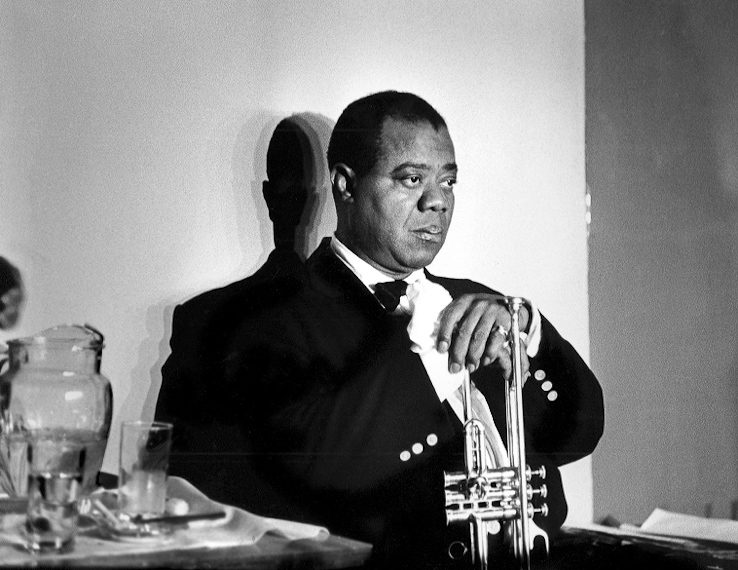Herman Leonard’s Jazz Portraits at the National Portrait Gallery
By • January 25, 2017 0 1743

In all of American art, there is no contribution more significant to history than jazz.
It is difficult to overstate this. The evolution of this electrifying new sound at the beginning of the 20th century was more revolutionary to music than any movement has ever been to fine art since, probably, the Renaissance. In fact, it is arguable that jazz was as significant to the idea of abstraction and instinctive expression in visual art as any painterly innovation.
Go find any random piano recording of Art Tatum and tell me that it is not a spiritual companion on a level with the best Jackson Pollock.
Jazz also came about at the right time, emerging when recording technology first allowed musical performances to be preserved. Instead of it being an exclusively live experience, the sensation of music could suddenly be reproduced and distributed, allowing the genius of individual artists to be enjoyed regularly around the world.
But when it comes to visualizing jazz, no one captured the feeling of the music quite like photographer Herman Leonard.
Through his photographs of its major players, the jazz era of the 1940s and ’50s — the cradle of this creative explosion — comes to life. The emotion and physicality of performance pulse through Leonard’s work, along with the clink of glasses from the audience, the whispering sizzle of cigarettes and stage lights, the intoxicating atmosphere that the jazz scene bred.
Born in 1923, Leonard devoured and documented that scene in New York City for about a decade beginning in the late 1940s. His images of jazz musicians are widely regarded as the definitive portraits of many of the 20th-century’s greatest artists.
At the National Portrait Gallery through Feb. 20, “In the Groove: Jazz Portraits by Herman Leonard” showcases 30 of his black-and-white photographs, iconic pictures of Louis Armstrong, Ella Fitzgerald, Miles Davis, Billie Holiday, Nat “King” Cole, Duke Ellington, Frank Sinatra, Sarah Vaughan and Dinah Washington, to name a few. These are artists whose styles and stories are woven into our cultural fabric.
Leonard apprenticed to portrait photographer Yousuf Karsh, accompanying him to portrait sessions with famous sitters such as Albert Einstein and Martha Graham. After launching his first studio in 1948 in Greenwich Village, Leonard was led by his infatuation with jazz to clubs and performance venues all over the city. With his camera in tow, he began to make images that soon started to appear on album covers and in leading music magazines.
Considering how much life pulses through Leonard’s photographs, it is unfortunate that the Portrait Gallery handles the exhibition with such scholarly dryness. The labels go over each musician’s history, covering the timelines of his or her career, but somehow everything that made them important as artists is missing. The show forgoes any effort to communicate the energy and virtuosic bravura that makes jazz so thrilling, not to mention the particular beauty of Leonard’s photographs. The artistry of the photographs isn’t even referred to, save for a short line in the introductory panel.
Here is how the panel for Louis Armstrong reads: “A trumpet virtuoso and innovative vocalist, jazz pioneer Louis Armstrong helped to transform jazz into an international phenomenon.”
There is nothing wrong with that statement, except that Louis Armstrong is a god, a giant, an honest-to-goodness American miracle sent to earth to transform music forever. Without Louie, there is no modern music: there is no Chuck Berry, no Elvis, no Beatles, no Bruce Springsteen, no Beyoncé or Kanye or anything. Before Louie, America’s most significant contribution to music was the foxtrot. This seems like an opportunity missed.
And what of Leonard’s photograph of Armstrong? Here we see not the venerable showman who transcended the vaudevillian caricatures into which the entertainment industry first boxed him, who paved a new road for black entertainers by finding dignity in the most demeaning of work. (Go right now and YouTube “Louis Armstrong performs Shine” to watch an artist rise above the constraints of stereotypical schlock like you’ve never seen.)
Leonard’s portrait shows an exhausted warrior, a gladiator resting between battles, forever stained by the spotlight, even as he sits offstage. He slumps in a chair with his hands resting on his trumpet, his weapon and his shield, this coiled engine of radiant brass his salvation and his prison. It is a remarkable and surprising image.
All of the portraits are profoundly beautiful (if not equally revealing), managing to capture something unique about the rich interior lives of each artist. Perhaps most wonderful of all are his portraits of Thelonious Monk, Duke Ellington and Billie Holiday, each a master class in tone, mood and visual narrative. The photograph of Ellington is like a living elegy, showing the giant in shadow and light.
The history these stunning works contain is almost heart-wrenching. It’s a privilege that they even exist. Put on your headphones, crank up the Satchmo and enjoy this journey into the heart of our musical history.

